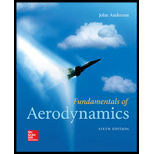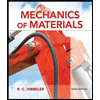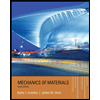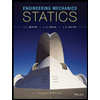
Concept explainers
Note: In the following problems, you will deal with both the International System of Units (SI) (N, kg, m, s, K) and the English Engineering System (lb, slug, ft, s,
The temperature and pressure at the stagnation point of a high-speed missile are
The density of missile at the stagnation point.
Answer to Problem 7.1P
The density of missile at stagnation point is
Explanation of Solution
Given Information:
Calculation:
From ideal gas equation, the density at the given point can be calculated as,
Hence, the density of missile at the stagnation point is
Want to see more full solutions like this?
Chapter 7 Solutions
Fundamentals of Aerodynamics
Additional Engineering Textbook Solutions
Automotive Technology: Principles, Diagnosis, and Service (5th Edition)
Degarmo's Materials And Processes In Manufacturing
Manufacturing Engineering & Technology
Machine Elements in Mechanical Design (6th Edition) (What's New in Trades & Technology)
Fundamentals of Heat and Mass Transfer
Fluid Mechanics: Fundamentals and Applications
- C1 (a). A lubricating oil having the dynamic viscosity of 0.055 poise and kinematic viscosity of 0.17 stokes. Calculate (i) the density of oil in kg/m3, (ii) the weight density of oil in N/m3,(iii) the specific gravity, and (iv) the specific volume in m3/kg. C1 (b). Calculate the capillary effect in mm in a glass tube of 4.4 mm diameter, when immersed in (1) water (2) mercury. The values of surface tension in contact with air are 0.0737 N/m and 0.54 N/m respectively. The contact angle for water =00 and mercury =1300. (Enter only the values by referring to the unit given. Also, upload the handwritten answers in the link provided) C1(a).(i).The density of oil in kg/m3 C1(a). (ii) the weight density of oil in N/m3 C1(a). (iii) the specific gravity C1(a). (iv) the specific volume in m3/kg C1 (b). 1.The capillary effect (water) in mm C1 (b). 2.The capillary effect (mercury) in mmarrow_forwardDetermine the Mach Number of an airplane flying with a speed of 677 knots at a standard altitude of 39,344 ft.arrow_forwardIn medical work, pressures are often measured in units of mm of H2O because body fluids, including the cerebrospinal fluid, typically have nearly the same density as water. The pressure of the cerebrospinal fluid can be measured by means of a spinal tap. A hollow tube is inserted into the spinal column, and the height to which the fluid rises is observed. If the fluid rises to a height of 160 mm, we write its gauge pressure as 160 mm H2O. (a) Express this pressure in pascals, in atmospheres, and in millimeters of mercury.arrow_forward
- In medical work, pressures are often measured in units of mm of H2O because body fluids, including the cerebrospinal fluid, typically have nearly the same density as water. The pressure of the cerebrospinal fluid can be measured by means of a spinal tap. A hollow tube is inserted into the spinal column, and the height to which the fluid rises is observed. If the fluid rises to a height of 160 mm, we write its gauge pressure as 160 mm H2O. a) Sometimes it is necessary to determine whether an accident victim has suffered a crushed vertebra that is blocking the flow of cerebrospinal fluid in the spinal column. In other cases, a physician may suspect that a tumor or other growth is locking the spinal column and inhibiting the flow of cerebrospinal fluid. Such conditions can be investigated by means of the Queckensted test. In this procedure the veins in the patient’s neck are compressed, to make the blood pressure rise in the brain. The increase in pressure in the blood vessels is…arrow_forwardThe speed of a supersonic aircraft flying at an altitude of 1,100 meters corresponds to a Mach number of 2.5. Estimate the time elapsed, in seconds, between the instant the aircraft was directly over head of an observer and the instant the observer feels the disturbance due to the aircraft. Presume that the temperature at the given height is 280°K, with k = 1.4 and R = 2.87 J/kg·K, in determining the questions of the following three cases: A) When the observer is stationaryB) When the observer is moving in the direction of the aircraft at M = 0.5C) When the observer is moving in the opposite direction with M = 0.5.arrow_forwardOn October 3, 1967, pilot William J. "Pete" Knight set a world record that still stands to this day for the fastest flight by a crewed, powered aircraft by flying the North American Aviation X-15 as fast as Mach 6.7 at an altitude of 102,000 ft above sea level. Mach number is the ratio of an object’s velocity to the local speed of sound. Using the table for atmospheric properties with respect to altitude, calculate the speed of sound at an altitude of 100,000 ft. What must have been the velocity of the X-15?arrow_forward
- If Reynolds number relate the inertial and viscous forces, which of the following relates the inertial andgravitational forces?A. Froude NumberB. Weber NumberC. Galileo NumberD. Eotvos Numberarrow_forwardThe surface tensions of mercury and water at 60 degrees Celcius are 0.47N/m and 0.0662 N/m, respectively. What capillary height changes will occur in these two fluids when they are in contact with air in a glass tube of radius 0.30mm? Use θ = 130° for mercury, and 0° for water; y = 132.3 kN/m3 for mercury and 9.650 kN/m3 for water. Provide the given along with its solution. (Please write legibly, I did not understand the first solution.)arrow_forward1 atm = 2116 lb/ft2 = 1.01 × 105 N/m2. Calculate cp, cv, e, and h fora. The stagnation point of a high-speed missile are 934 ◦R and 7.8 atm, respectively.b. Air at standard sea level conditionsarrow_forward
- A high-flying jet cruising at 3000km/hr displays a Mach Number of 3.2. What is the speed of sound and the temperature of the air at that altitude?arrow_forwardSAE 10W30 motor oil has a dynamic viscosity of 0.21 kilograms per meter second and a specific gravity of 0.896 (a) What is the density of the motor oil in units of kilograms per cubic meter?arrow_forwardWhat is the difference between dynamin and kinematic viscosity? That is the significance of these properties of liquid?arrow_forward
 Elements Of ElectromagneticsMechanical EngineeringISBN:9780190698614Author:Sadiku, Matthew N. O.Publisher:Oxford University Press
Elements Of ElectromagneticsMechanical EngineeringISBN:9780190698614Author:Sadiku, Matthew N. O.Publisher:Oxford University Press Mechanics of Materials (10th Edition)Mechanical EngineeringISBN:9780134319650Author:Russell C. HibbelerPublisher:PEARSON
Mechanics of Materials (10th Edition)Mechanical EngineeringISBN:9780134319650Author:Russell C. HibbelerPublisher:PEARSON Thermodynamics: An Engineering ApproachMechanical EngineeringISBN:9781259822674Author:Yunus A. Cengel Dr., Michael A. BolesPublisher:McGraw-Hill Education
Thermodynamics: An Engineering ApproachMechanical EngineeringISBN:9781259822674Author:Yunus A. Cengel Dr., Michael A. BolesPublisher:McGraw-Hill Education Control Systems EngineeringMechanical EngineeringISBN:9781118170519Author:Norman S. NisePublisher:WILEY
Control Systems EngineeringMechanical EngineeringISBN:9781118170519Author:Norman S. NisePublisher:WILEY Mechanics of Materials (MindTap Course List)Mechanical EngineeringISBN:9781337093347Author:Barry J. Goodno, James M. GerePublisher:Cengage Learning
Mechanics of Materials (MindTap Course List)Mechanical EngineeringISBN:9781337093347Author:Barry J. Goodno, James M. GerePublisher:Cengage Learning Engineering Mechanics: StaticsMechanical EngineeringISBN:9781118807330Author:James L. Meriam, L. G. Kraige, J. N. BoltonPublisher:WILEY
Engineering Mechanics: StaticsMechanical EngineeringISBN:9781118807330Author:James L. Meriam, L. G. Kraige, J. N. BoltonPublisher:WILEY





